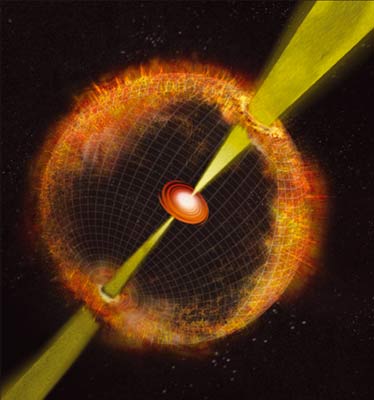
Artist’s rendering of an “engine-driven” supernova explosion with accretion disc and high-velocity jets.
Image credit: Bill Saxton, NRAO/AUI/NSF.
Long-duration gamma-ray bursts are associated with peculiar supernova explosions and a long-lived radio afterglow emission has been detected for some of them. So the discovery of relativistic radio ejecta from two supernovae not associated with detected gamma-ray bursts is a surprise. Did the gamma rays point away from Earth or were they trapped inside the star?
Gamma-ray bursts lasting more than several seconds are associated with peculiar supernova explosions of massive stars. They are thought to be generated by a central engine that is likely to be a newborn black hole at the heart of the dying star (CERN Courier September 2003 p15). These supernovae are all of spectral type Ibc (i.e. either Ib or Ic), which means that they are core-collapse supernovae with no evidence of hydrogen lines in the spectrum, suggesting that the massive star has previously blown away its outer envelope of hydrogen. Only about 1% of type Ibc supernovae display gamma-ray bursts and evidence for relativistic ejecta inferred from radio observations.
Previously, supernovae with relativistic outflows have only been found via their prompt gamma-ray emission. Now, however, A M Soderberg of the Harvard-Smithsonian Center for Astrophysics and collaborators report in Nature the discovery of mildly relativistic outflows in a supernova without a detected gamma-ray burst. They deduce the velocity of the blast-wave in this supernova, SN 2009bb, from the luminosity and frequency of the synchrotron spectral turnover that gives a measure of the size of the radio source at a given time after the onset of the supernova. They obtain a velocity of more than about 0.6 times the speed of light, which is interpreted as evidence for a central engine. The latter should have powered a gamma-ray burst coincident in time and position with SN 2009bb, but none was detected by the Interplanetary Network of spacecrafts sensitive to gamma-ray bursts.
The radio luminosity of SN 2009bb and its decay over several months matches very well that of SN 1998bw, which was the first supernova that could be associated with a gamma-ray burst. The latter, GRB 980425, is still the nearest detected gamma-ray burst at a distance of about 120 million light-years. The new event in the spiral galaxy NGC 3278 is at a similar distance. The absence of an associated gamma-ray burst could indicate that there were no gamma rays or that they were directed away from the line of sight. However, even if the gamma-ray signal was as bright as GRB 980425 it would not have been detectable by the Interplanetary Network. It could thus be that SN 2009bb is just a twin of SN 1998bw. Only two other supernovae have been detected so far to be associated with dim and nearby gamma-ray bursts, namely GRB 031203 (CERN Courier September 2004 p13) and the X-ray flash GRB 060218 (CERN Courier October 2006 p13).
SN 2007gr is another supernova that can now be added to the list. It also has a mildly relativistic outflow detected without gamma-ray emission. This independent discovery was reported in the same issue of Nature by a group of astronomers led by Z Paragi from the Joint Institute for Very Long Baseline Interferometry in Europe, the Netherlands, and from the MTA Research Group of Budapest. This time, the expansion of the supernova was directly measured from two high-resolution radio interferometric observations separated by 60 days.








